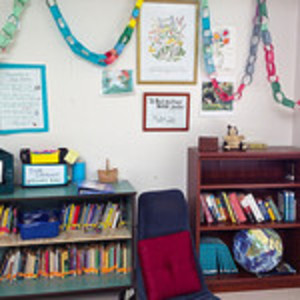I organize my middle school classroom library by literary genres. What is a genre? A genre is a category, or kind, of book. I help students determine a category of favorite books, and encourage them to begin selecting similar books. To track trends in their reading habits, my students record and rate books they have read or attempted. I then encourage my students to push themselves by slowly exploring other genre types.
I use my own reading habits as an example. I am drawn as a reader to realistic and historical fiction. I like stories that tug at my heartstrings. I have recently become a fan of dystopian novels, which falls into the science fiction category in my classroom. My goal this past year has been to explore the sports genre because I do not normally gravitate toward books about sports. I expect my students to do the same.
Literary Genres
Below is a genre list for my classroom library:
- Please keep in mind that many books will fall into more than one category. I choose the genre that I feel BEST fits that particular book.
- A fictional novel is a mostly made up story.
- A nonfiction book is composed entirely of facts.
1. Realistic Fiction: This is by far my largest section. Many novels that qualify for other literary genres also fit into this group. I put books here only if they do not fit in another, unique group. Examples include “Frindle” by Andrew Clements; and “The Babysitter Club” series, by Ann M. Martin.
2. Sports (Fiction): Although many of these books are also realistic in nature, they deserve their own category. These are fictional novels centered around athletics. Favorite authors in this area include Mike Lupica and John Feinstein. One of my personal favorites is “One Handed Catch“ by M J Auch, a novel about a young baseball fan who loses his hand in an accident.
3. Historical Fiction: These fictional novels contain true historical facts and figures. One of the favorites in my classroom is “My Brother Sam is Dead“ by James Lincoln Collier and Christopher Collier. It is a Revolutionary War novel about a fictional Timothy Meeker and his brother, Samuel. You can also find fictional books about slavery, the Civil War, and the Dust Bowl, along with many more.
4. Mysteries: This includes the “whodunit?” novels, Nancy Drew, and the ever-popular R.L. Stine. Any book with a good mystery to solve that may or may not fit into another category.
5. Graphic Novels: Graphic novels have become very popular with young readers, so I like to place these in their own section. Graphic novels are a book in the form of a comic strip. In this section, I include the popular “Diary of a Wimpy Kid” series and the graphic novel version of “Twilight. Although these books would fit into the genres of realistic fiction and fantasy, respectively, I prefer to pull them to make them easier to locate.
6. Westerns (Fiction): I have a few students interested in stories about the Old West. Books by Louis L’amour and John R. Erickson’s “Hank the Cowdog” series are found here.
7. Science Fiction: Science fiction should not be confused with fantasy. Sci-Fi novels are stories whose plots revolve around science and technology in the future. Space, robots, and time travel are all found in this section. Dystopian novels would also belong. The Hunger Games” and “Jurassic Park” are popular.
8. Fantasy: Good ol’ Harry Potter! This is the section for him. Fantasy includes novels with magic, magical beings, animals that talk, giants, and more. This is the most popular area for kids by far!
9. Myths and Fairy Tales: Since 6th graders study ancient mythology, I like to display these books in their own section. Fairy tales and myths are stories that have been orally passed from generation to generation and are specific to a particular culture. Mythology includes stories about gods and heroes of a society. Fairy tales are stories such as “Little Red Riding Hood” and “Cinderella”.
10. Poetry: Here I include all poetry. Favorite poets include Shel Silverstein and Maya Angelo.
11. Nonfiction: This is a rather large section and could include poetry, myths, and fairy tales. In my library, this is where I place all factual books such as biographies, reference books, books about states, and books about animals. I also include biographical novels and encourage students to occasionally branch out to this section.
Most books should fit into these eleven genres. It is not necessary to divide them into this many genres if you do not have the shelf space for display. Find a method that works for you and your readers. Look for trends in book popularity and plan accordingly.
Happy reading!
More articles from this contributor:
4 Easy Ways to Promote Reading in Your Home
Geocaching: Outdoor Treasure Hunting Fun
